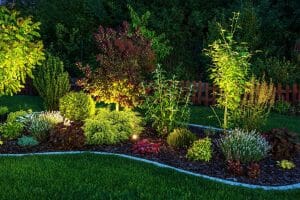A beautiful, well-manicured landscape provides an aesthetic frame to one of your most important assets: your home.
 And yet, many lawns and landscapes are hidden more than 50% of the year for one unavoidable natural phenomenon: night.
And yet, many lawns and landscapes are hidden more than 50% of the year for one unavoidable natural phenomenon: night.
Landscape lighting highlights landscape beds, ornamental trees, walkways, and landscape fixtures around your home, which not only adds another depth of aesthetic value, but also increases security.
So, is outdoor lighting right for you?
Let’s find out.
Benefits of Landscape Lighting
The major benefit of outdoor lighting is visibility.
Outdoor visibility at night provides the following:
- Increased security
- Visible walkways
- Usable outdoor areas
- Focused attention on major landscape elements. An added layer of curb appeal.
- The ability to see your outdoor space makes it safer and more accessible.
Benefits of Professional Installation
Landscape professionals offer a range of services; one of which is landscape lighting installation and maintenance.
One benefit of professional installation is the dual expertise in landscape design and maintenance. Professionals can identify which parts of the landscape should be highlighted and the best security light placement.
Some of the services offered by professional installers include:
- Automatic timers
- High-quality materials
- Professional design
- Seasonal maintenance
Contact us for more information on our landscape lighting services.
Lighting Options
There are four major categories of landscape lighting:
- Security lights
- Path lights
- Accent lights
- Spotlights
Most security lights are bright, motion-sensing floodlights placed up high on the corners of buildings. These lights illuminate large portion of the outdoors when animals or people pass by.
Path lights illuminate walkways throughout the lawn and garden area. Path lights have a soft to medium brightness and sit low to the ground.
Accent lights can be lanterns, sconces, string lighting, deck lighting, and other lighting options that make outdoor spaces usable and enjoyable at night.
Spotlights enhance the aesthetic appearance of the landscape. These lights highlight specimen plants, water features, and other statement pieces in the landscape.
Landscape Lighting Elements
A successful landscape lighting system is composed of high-quality equipment and an artistic design.
When you’re deciding on a lighting design, it’s important to take lighting effects into consideration.
There are four main lighting applications:
- Uplighting – This is pointed directly upward onto a plant or landscape fixture.
- Downlighting – This is pointed directly downward onto a plant or landscape fixture.
- Path/Area lighting – This is a short light with a top that directs light back down onto a pathway or lawn area.
- Specialty lighting – These are pond lights, step lights, post lights, and other lighting that provides accents to hardscapes and other landscape fixtures.
Common components in a lighting design include:
- Spotlights – These lights are used as up lights, down lights, and floodlights to highlight specific portions of the landscape.
- Floodlights – These are used to flood large areas with bright light for security.
- Hardscape lights – These lights are installed on hard landscape surfaces, like patios and walkways. They are used to light up surfaces to make them safer and more usable at night.
- Step lights – These lights are used to illuminate steps to make them more visible. These lights are installed underneath each step to provide subtle visibility.
- Path & area lights – These lights point down toward paths or to illuminate areas underfoot.
- In-ground lights – These lights are sunk into the ground and produce a stream of light directly up into a large structure.
- Post lights – These lights could be lanterns, spotlights, or other types of accent lights meant to light up boundaries or pathways.
- Pond lights – These lights are used to illuminate aquatic landscape features either above or below the surface.
These lights and applications can provide five lighting effects in a landscape:
- Moonlighting – This is an effect that mimics natural moonlight. Lights are placed in trees and pointed down onto decks or patio areas to capture the shadows and movement of the branches while lighting the area.
- Silhouetting – This is an effect created by putting a light between a plant or landscape fixture and a structure. The backlighting creates a silhouette that illuminates the plant material or fixture in the front.
- Shadowing – This is an effect created by directing lights onto objects to cast a shadow onto a visible surface. This is especially striking with statues or moving objects.
- Washing – This is an effect that washes an entirely flat surface, like a wall or hedge, in soft light. Shadows and highlights are eliminated.
- Spotlighting – This is an effect that directly highlights a plant or landscape fixture. Spotlights should be used sparingly to prevent a washed-out look.
Outdoor lighting allows you to enjoy your lawn and landscape in new ways, while providing an extra layer of security.
For more information on installing a professional landscape lighting system, please contact us.
